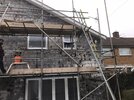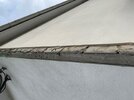R
RedHerring2
Quick question.
Specification for our extension to bungalow is render on 100mm blocks, 50mm partial fill (25mm Kingspan K8 ), 100mm Besblock Cellular Insulite blocks for internal skin with 25mm (K17) insulation and 12.5mm pb on internal.
I've substituted 25mm Kingspan K8 for 30mm Xtratherm and I was intending substituting Besblock Cellular Insulite for 3.6N Thermalite Shield blocks for internal skin.
1. Can I use same Thermalite blocks for outer skin?
2. Bearing in mind the speed I work, it'll be next winter before I render. Is it advisable to leave Thermalite blocks open to the elements for that long?
Specification for our extension to bungalow is render on 100mm blocks, 50mm partial fill (25mm Kingspan K8 ), 100mm Besblock Cellular Insulite blocks for internal skin with 25mm (K17) insulation and 12.5mm pb on internal.
I've substituted 25mm Kingspan K8 for 30mm Xtratherm and I was intending substituting Besblock Cellular Insulite for 3.6N Thermalite Shield blocks for internal skin.
1. Can I use same Thermalite blocks for outer skin?
2. Bearing in mind the speed I work, it'll be next winter before I render. Is it advisable to leave Thermalite blocks open to the elements for that long?




